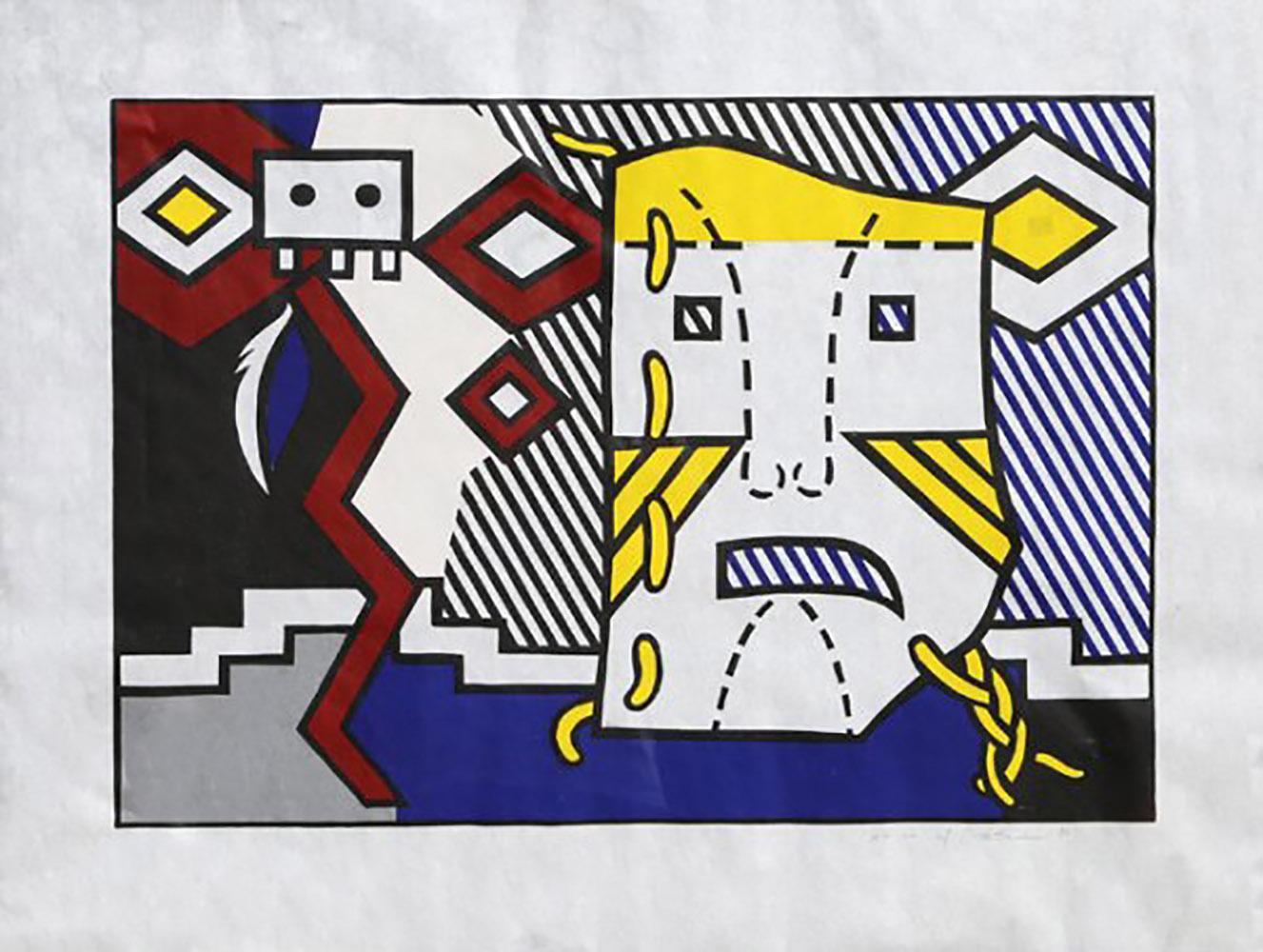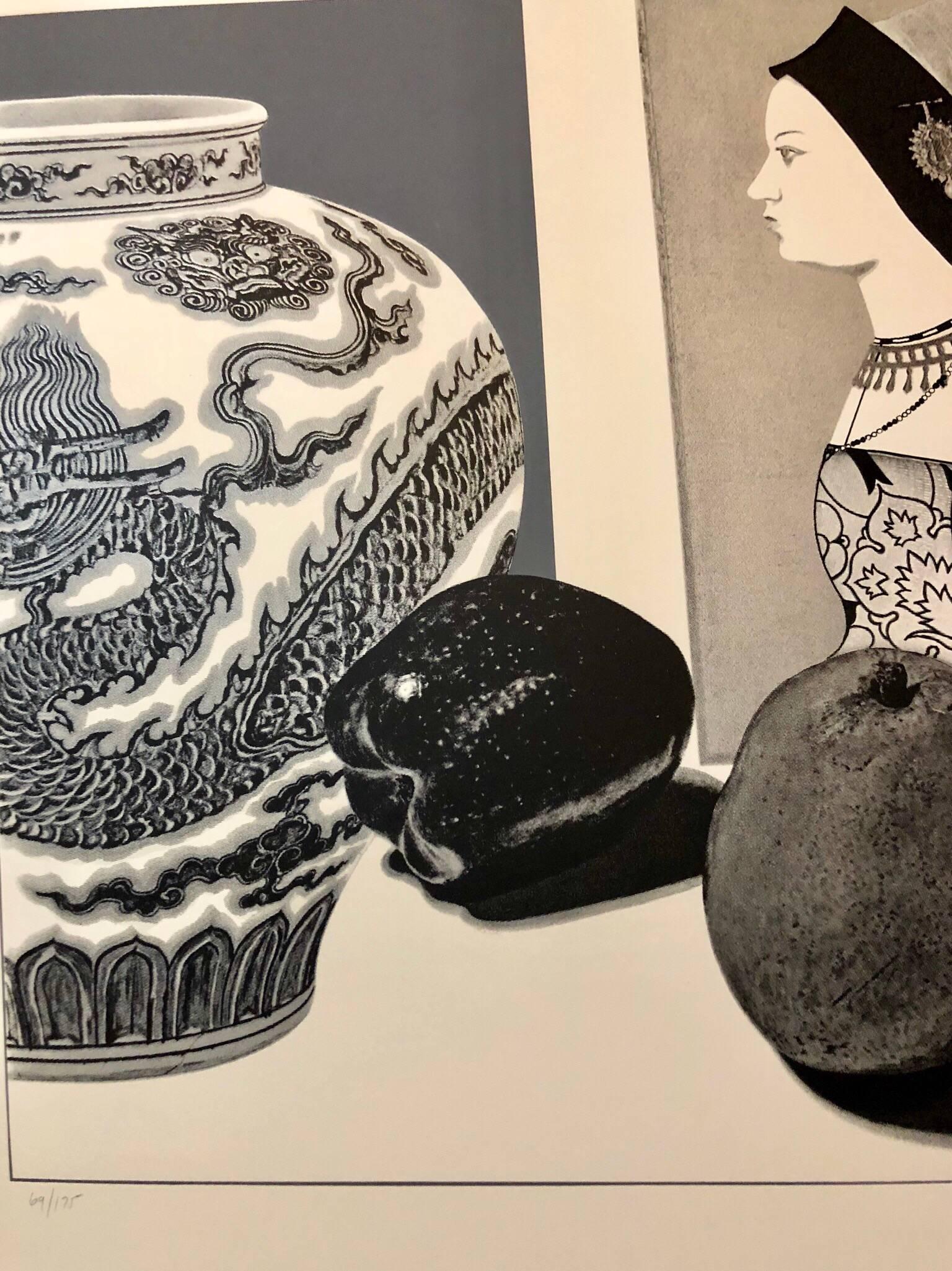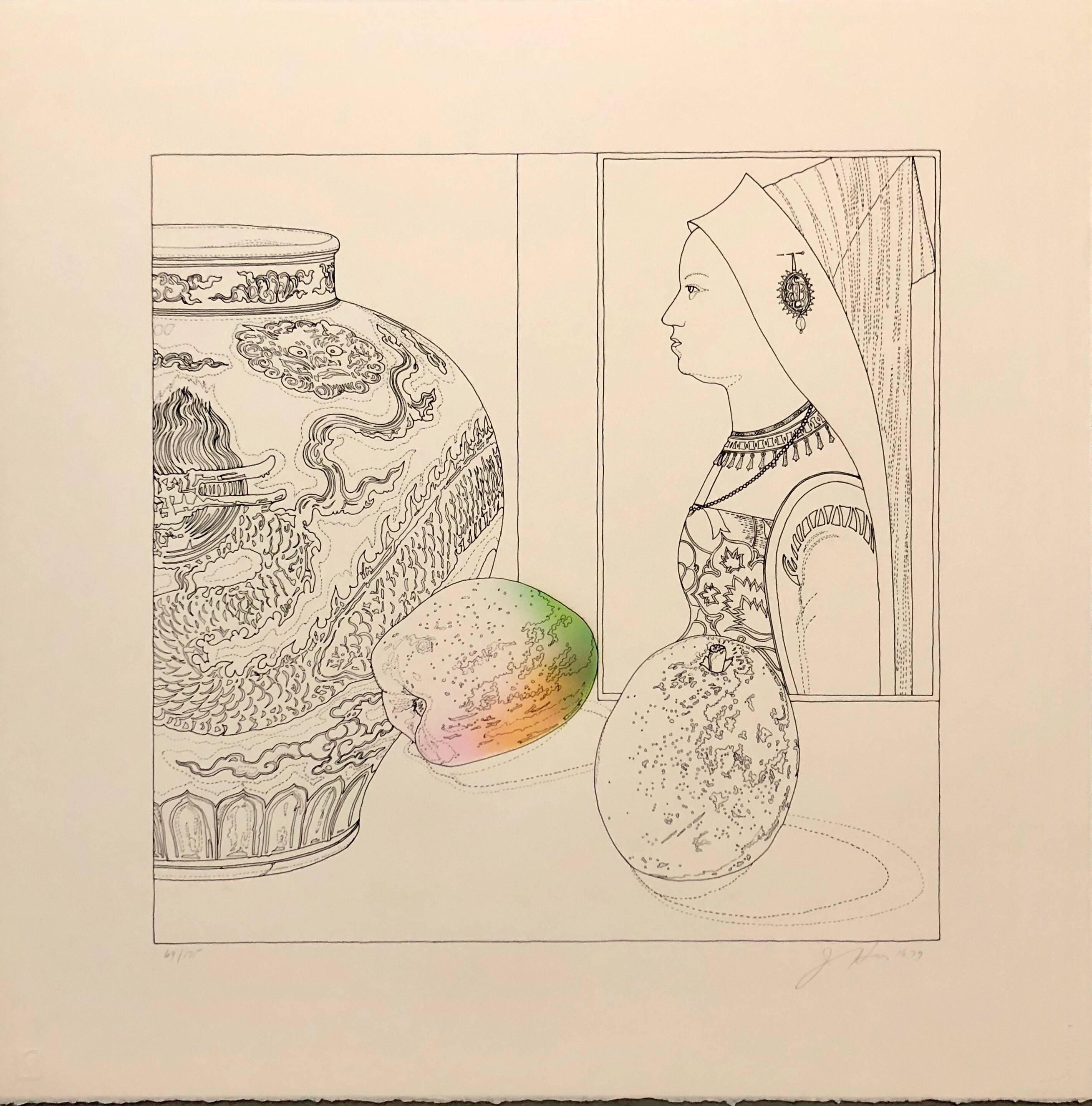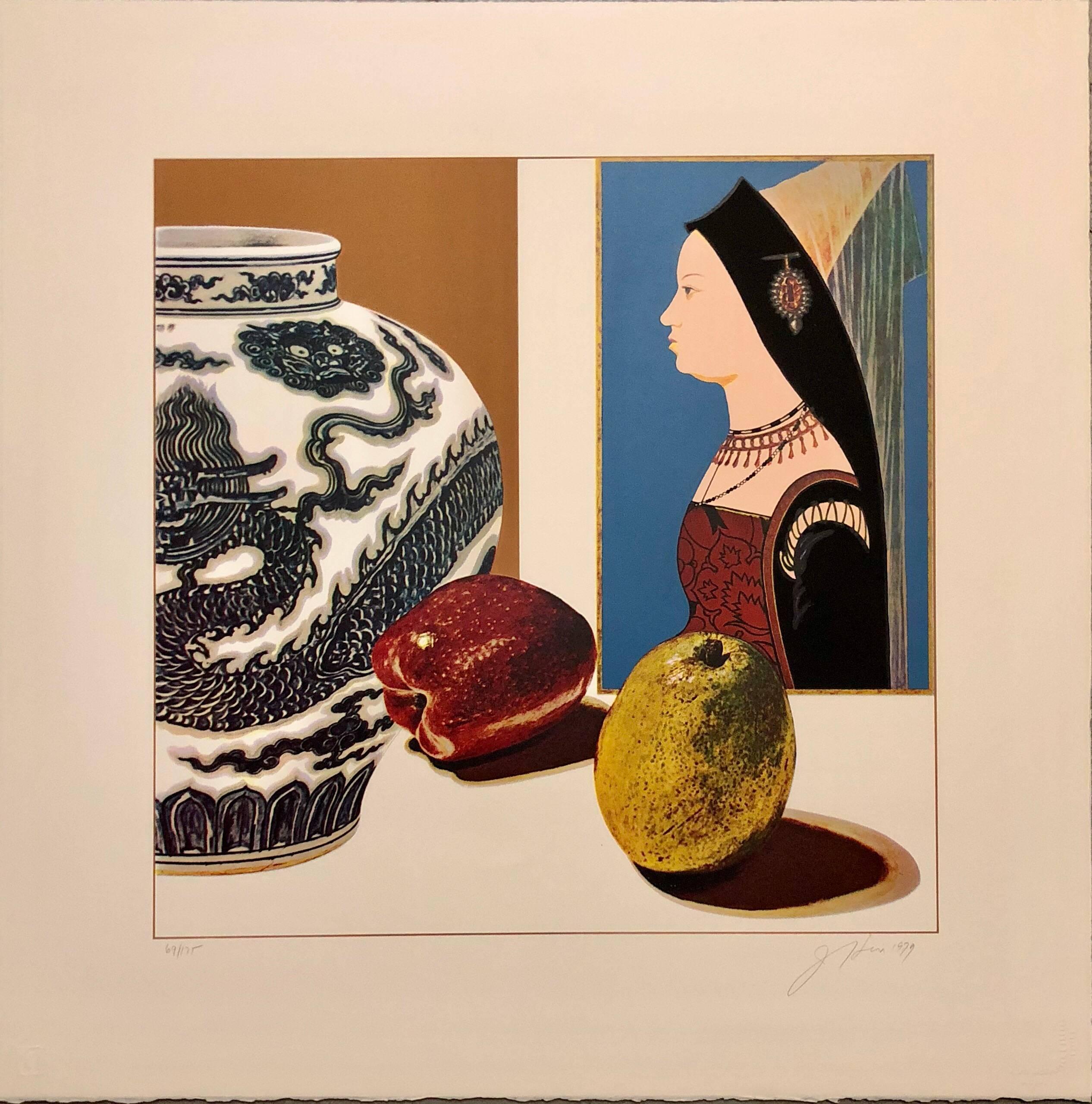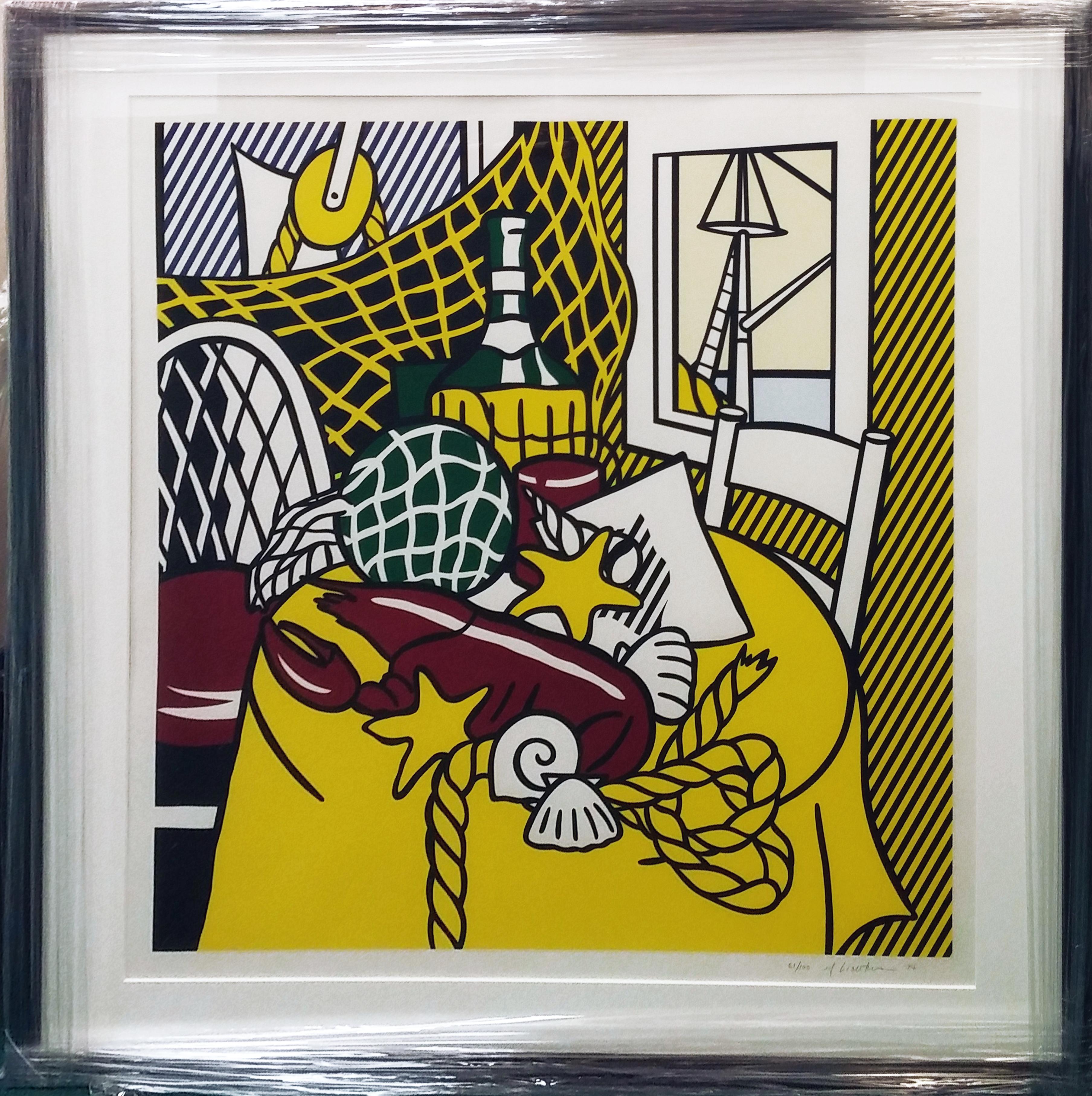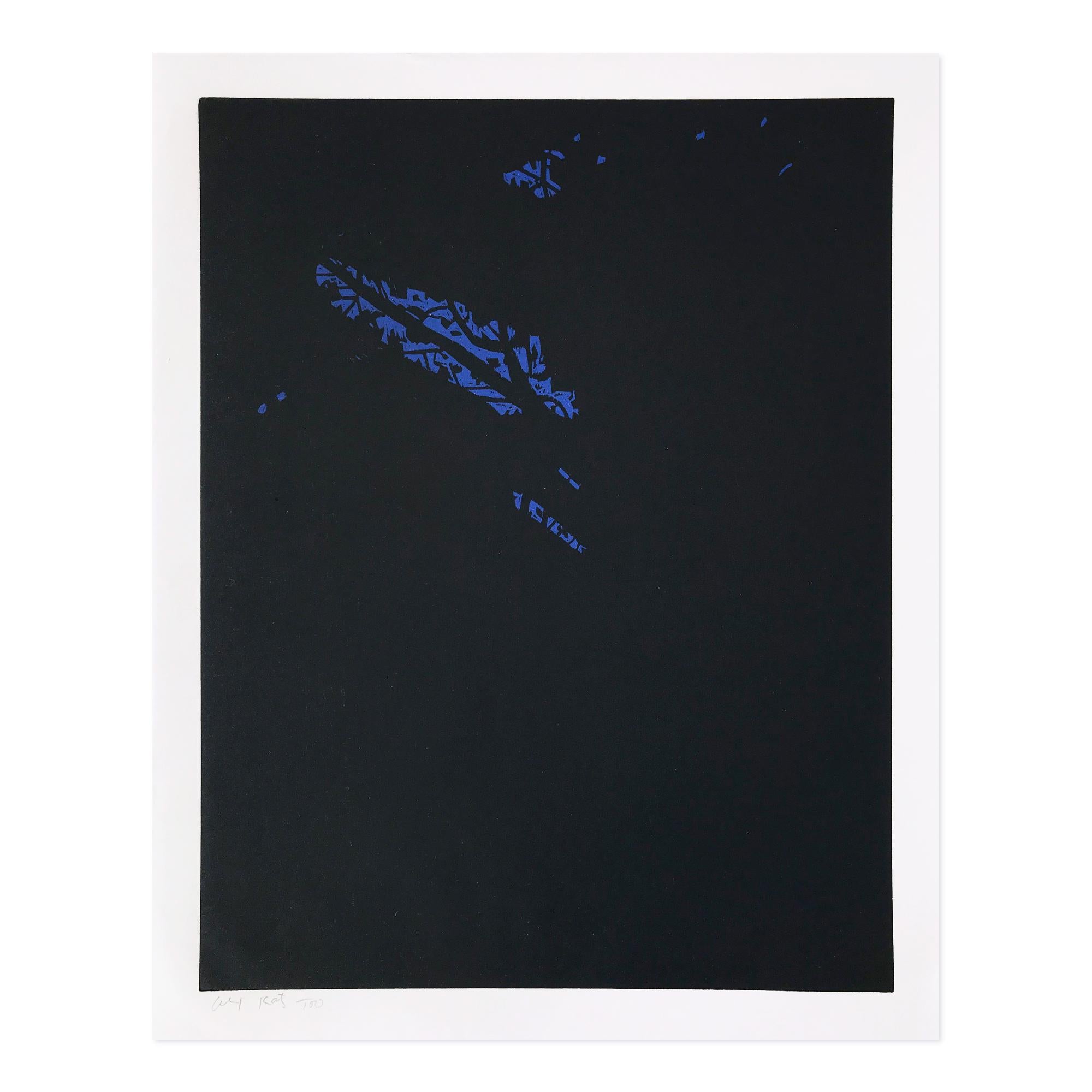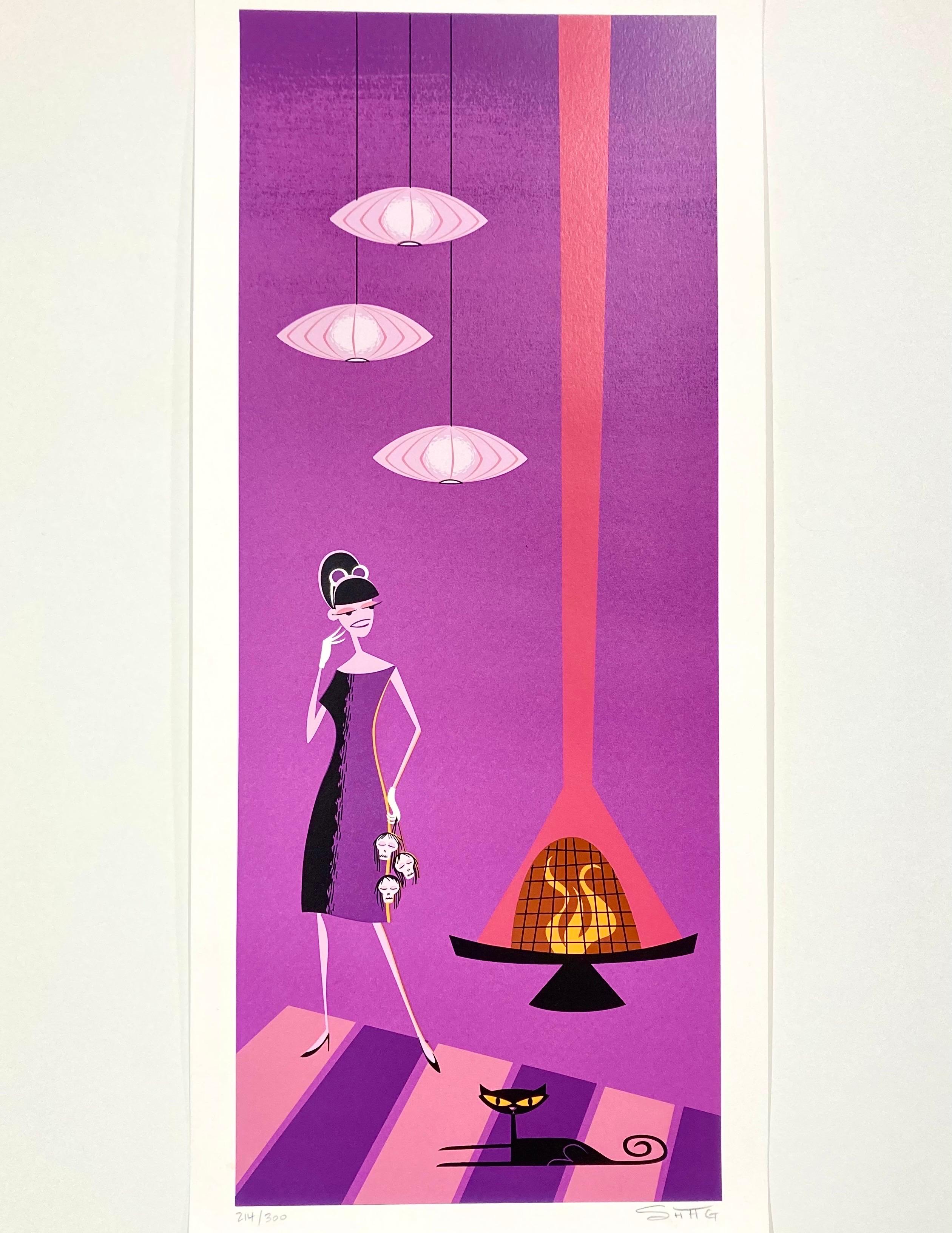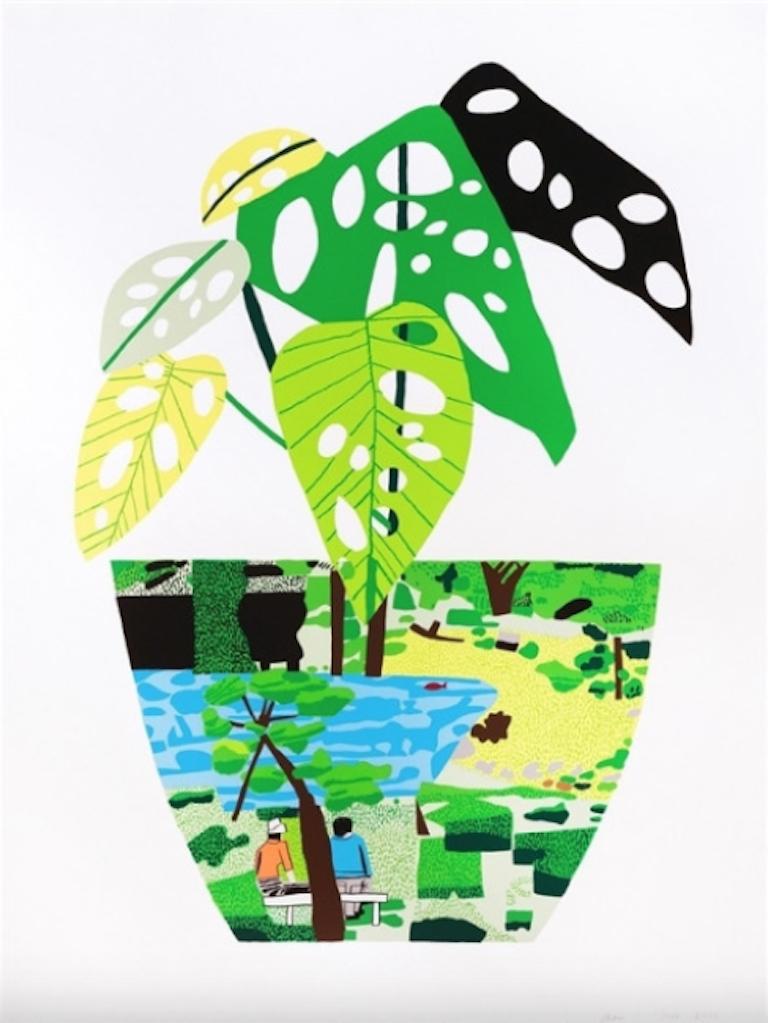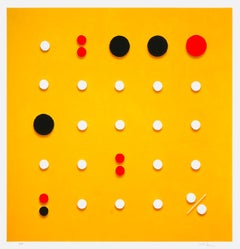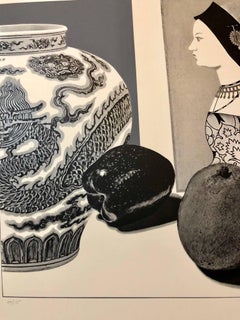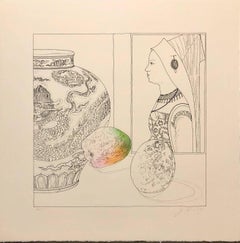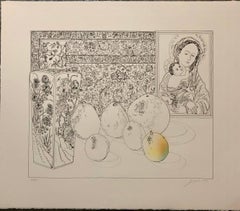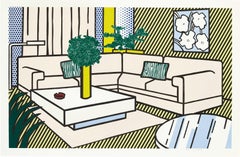
Yellow Vase, from Interior Series
View Similar Items
Roy LichtensteinYellow Vase, from Interior Series1990
1990
About the Item
- Creator:Roy Lichtenstein (1923 - 1997, American)
- Creation Year:1990
- Dimensions:Height: 55.63 in (141.31 cm)Width: 84.38 in (214.33 cm)
- Medium:
- Movement & Style:
- Period:
- Condition:
- Gallery Location:New York, NY
- Reference Number:1stDibs: LU118526784562
Roy Lichtenstein
Roy Lichtenstein is one of the principal figures of the American Pop art movement, along with Andy Warhol, James Rosenquist, Claes Oldenburg and Robert Rauschenberg.
Drawing inspiration from comic strips, Lichtenstein appropriated techniques commercial printing in his paintings, introducing a vernacular sensibility to the visual landscape of contemporary art. He employed visual elements such as the halftone dots that comprise a printed image, and a comic-inspired use of primary colors gave his paintings their signature “Pop” palette.
Born and raised in New York City, Lichtenstein enjoyed Manhattan’s myriad cultural offerings and comic books in equal measure. He began painting seriously as a teenager, studying watercolor painting at the Parsons School of Design in the late 1930s, and later at the Art Students League, where he worked with American realist painter Reginald Marsh. He began his undergraduate education at Ohio State University in 1940, and after a three-year stint in the United States Army during World War II, he completed his bachelor’s degree and then his master’s in fine arts. The roots of Lichtenstein’s interest in the convergence of high art and popular culture are evident even in his early years in Cleveland, where in the late 1940s, he taught at Ohio State, designed window displays for a department store and painted his own pieces.
Working at the height of the Abstract Expressionist movement in the 1950s, Lichtenstein deliberately eschewed the sort of painting that was held in high esteem by the art world and chose instead to explore the visual world of print advertising and comics. This gesture of recontextualizing a lowbrow image by importing it into a fine-art context would become a trademark of Lichtenstein’s artistic style, as well as a vehicle for his critique of the concept of good taste. His 1963 painting Whaam! confronts the viewer with an impact scene from a 1962-era issue of DC Comics’ All American Men of War. Isolated from its larger context, this image combines the playful lettering and brightly colored illustration of the original comic with a darker message about military conflict at the height of the Cold War. Crying Girl from the same year featured another of Lichtenstein’s motifs — a woman in distress, depicted with a mixture of drama and deadpan humor. His work gained a wider audience by creating a comic-inspired mural for the New York State Pavilion of the 1964 World's Fair, he went on to be represented by legendary New York gallerist Leo Castelli for 30 years.
In the 1970s and ’80s, Lichtenstein experimented with abstraction and began exploring basic elements of painting, as in this 1989 work Brushstroke Contest. In addition to paintings in which the brushstroke itself became the central subject, in 1984 he created a large-scale sculpture called Brushstrokes in Flight for the Port Columbus International Airport in Ohio. Still Life with Windmill from 1974 and the triptych Cow Going Abstract from 1982 both demonstrate a break from his earlier works where the subjects were derived from existing imagery. Here, Lichtenstein paints subjects more in line with the norms of art history — a pastoral scene and a still life — but he has translated their compositions into his signature graphic style, in which visual elements of printed comics are still a defining feature.
Lichtenstein’s work is represented in the collections of the Metropolitan Museum of Art, the Museum of Modern Art, Tate Modern, and many others. He was awarded National Medal of Arts in 1995, two years before he passed away.
Find a collection of Roy Lichtenstein prints, drawings and more on 1stDibs.
- Landscape Pot with PlantBy Jonas WoodLocated in New York, NY2017 Screenprint in colors, on 410gsm Somerset tub sized Satin Enhanced White paper Sheet: 39 2/5 x 29 1/2 inches Edition of 100 Signed, dated and numbered in pencil Framed, mint con...Category
2010s Pop Art Interior Prints
MaterialsScreen
Price Upon Request - In the Studio (from My Normandy series)By David HockneyLocated in New York, NY2019 Inkjet print in colors on wove paper 34 x 43 in. (86.4 x 109.2 cm) Edition of 35 Signed, dated, and numbered in pencil, lower margin Framed, excellent conditionCategory
2010s Pop Art Interior Prints
MaterialsPaper, Inkjet
Price Upon Request - Rubber DuckLocated in New York, NY2023 Archival pigment print on wove paper Sheet: 24 x 24 in. (61 x 61 cm) Edition of 35 Signed and numbered in pencil, lower marginCategory
2010s Pop Art Interior Prints
MaterialsPaper, Archival Pigment
Price Upon Request - Love YouLocated in New York, NYLove You, 2023 Archival pigment print on wove paper 30 x 30 in. (76.2 x 76.2 cm) Edition of 50 + 5AP Signed and numbered in pencil, lower marginCategory
2010s Conceptual Interior Prints
MaterialsPaper, Digital Pigment
- Reflections on CrashBy Roy LichtensteinLocated in New York, NY1990 Lithograph, screenprint on paper and metalised PVC on paper S. 59 1/8 x 75 in. (150.2 x 190.5 cm) Edition of 68 Signed, dated and numbered in pencil, lower marginCategory
1990s Pop Art Abstract Prints
MaterialsPaper, Lithograph, Screen
Price Upon Request - Reflections on CrashBy Roy LichtensteinLocated in New York, NY1990 Lithograph, screenprint, relief, and metallized PVC collage with embossing on mold-made Somerset paper 51 1/8 x 75 in. (129.9 x 190.5 cm) Edition of 68 Signed, dated, and number...Category
1990s Pop Art Figurative Prints
MaterialsPaper, Lithograph, Screen
Price Upon Request
- Still Life with Hans Maler Pop Art Serigraph Hand SignedBy Josef LeviLocated in Surfside, FLOn deckle edged watermarked Arches French paper. hand signed in pencil, dated and numbered. the edition size is 175. there are three states of the same image image each with increasing detail and color. This is just for the one in the photo. Josef Alan Levi (1938) is an American artist whose works range over a number of different styles, but which are unified by certain themes consistently present among them. Josef Levi began his artistic career in the 1960s and early '70s, producing highly abstract and very modernist pieces: these employing exotic materials such as light fixtures and metallic parts. By 1975, Levy had transitioned to painting and drawing still lifes. At first these were, traditionally, of mundane subjects. Later, he would depict images from art history, including figures originally created by the Old Masters. Around 1980, he made another important shift, this time toward creating highly precise, though subtly altered reproductions of pairs of female faces which were originally produced by other artists. It is perhaps this work for which he is most well known. Since around 2000, Josef Levi has changed the style of his work yet again: now he works entirely with computers, using digital techniques to abstract greatly from art history, and also from other sources. Levi's works of art in the collections of the Museum of Modern Art, NYC, the National Gallery of Art, and the Albright-Knox Museum, among many others. Levi's art has been featured on the cover of Harper's Magazine twice, once in June 1987, and once in May 1997. Josef Levi received a Bachelor of Arts degree in 1959 from the University of Connecticut, where he majored in fine arts and minored in literature. From 1959 to 1960, he served to a first lieutenant in the U.S. Army, and from 1960 through 1967 he was in the U.S. Army Reserves. In 1966, he received the Purchase Award from the University of Illinois in 1966, and he was featured in New Talent U.S.A. by Art in America. He was an artist in residence at Appalachian State University in 1969, taught at Farleigh Dickenson University in 1971 and was a visiting professor of art at Pennsylvania State University in 1977. From 1975 to 2007, Levi resided in New York City. He now lives in an apartment in Rome, where he is able to paint with natural light as he was unable in New York. From 1959 to 1960, Josef took some courses of Howard McParlin Davis and Meyer Schapiro at Columbia University which initiated him into the techniques of reproducing the works of the Old Masters. His first works, created in the 1960s, were wood and stone sculptures of women. His first mature works were abstract pieces, constructed of electric lights and steel. In 1970, Levi's materials included fluorescent light bulbs, Rust-Oleum and perforated metal in addition to paint and canvas. By 1980, Josef Levi's art had transformed into a very specific form: a combination of reproductions of female faces which were originally depicted by other artists. The faces which he reproduces may be derived from either portraits or from small portions of much larger works; they are taken from paintings of the Old Masters, Japanese ukiyo-e, and 20th-century art. Artists from whom he has borrowed include: Vermeer, Rembrandt, Piero della Francesca, Botero, Matisse, Utamaro, Correggio, Da Vinci, Picasso, Chuck Close, Max Beckmann, Pisanello, Lichtenstein. The creation of these works is informed by Levi's knowledge and study of art history. Josef Levi's paintings from this period are drawn, then painted on fine linen canvas on wooden stretchers. The canvas is coated with twenty-five layers of gesso in order to produce a smooth surface on which to work. The drawing phase takes at least one month. Levi seals the drawing with acrylic varnish, and then he may apply layers of transparent acrylic in order to approximate the look of old paintings. After the last paint is applied, another layer of acrylic varnish is sprayed on to protect the work. Most of the figures in his contemporary pieces are not paired with any others. SELECTED COLLECTIONS MUSEUM OF MODERN ART, NEW YORK, NY ALBRIGHT- KNOX GALLERY, BUFFALO, NY ALDRICH MUSEUM OF CONTEMPORARY ART, RIDGEFIELD, CT NATIONAL GALLERY OF ART, WASHINGTON, DC BROOKLYN MUSEUM OF ART, BROOKLYN, NY SMITHSONIAN NATIONAL MUSEUM OF AMERICAN HISTORY, WASHINGTON, DC CORCORAN GALLERY, WASHINGTON, DC UNIVERSITY OF NOTRE DAME ART...Category
1970s Pop Art Figurative Prints
MaterialsLithograph, Screen
- Still Life with Hans Maler Pop Art Serigraph Hand SignedBy Josef LeviLocated in Surfside, FLOn deckle edged watermarked Arches French paper. hand signed in pencil, dated and numbered. the edition size is 175. there are three states of the same image image each with increasing detail and color. This is just for the one in the photo. Josef Alan Levi (1938) is an American artist whose works range over a number of different styles, but which are unified by certain themes consistently present among them. Josef Levi began his artistic career in the 1960s and early '70s, producing highly abstract and very modernist pieces: these employing exotic materials such as light fixtures and metallic parts. By 1975, Levy had transitioned to painting and drawing still lifes. At first these were, traditionally, of mundane subjects. Later, he would depict images from art history, including figures originally created by the Old Masters. Around 1980, he made another important shift, this time toward creating highly precise, though subtly altered reproductions of pairs of female faces which were originally produced by other artists. It is perhaps this work for which he is most well known. Since around 2000, Josef Levi has changed the style of his work yet again: now he works entirely with computers, using digital techniques to abstract greatly from art history, and also from other sources. Levi's works of art in the collections of the Museum of Modern Art, NYC, the National Gallery of Art, and the Albright-Knox Museum, among many others. Levi's art has been featured on the cover of Harper's Magazine twice, once in June 1987, and once in May 1997. Josef Levi received a Bachelor of Arts degree in 1959 from the University of Connecticut, where he majored in fine arts and minored in literature. From 1959 to 1960, he served to a first lieutenant in the U.S. Army, and from 1960 through 1967 he was in the U.S. Army Reserves. In 1966, he received the Purchase Award from the University of Illinois in 1966, and he was featured in New Talent U.S.A. by Art in America. He was an artist in residence at Appalachian State University in 1969, taught at Farleigh Dickenson University in 1971 and was a visiting professor of art at Pennsylvania State University in 1977. From 1975 to 2007, Levi resided in New York City. He now lives in an apartment in Rome, where he is able to paint with natural light as he was unable in New York. From 1959 to 1960, Josef took some courses of Howard McParlin Davis and Meyer Schapiro at Columbia University which initiated him into the techniques of reproducing the works of the Old Masters. His first works, created in the 1960s, were wood and stone sculptures of women. His first mature works were abstract pieces, constructed of electric lights and steel. In 1970, Levi's materials included fluorescent light bulbs, Rust-Oleum and perforated metal in addition to paint and canvas. By 1980, Josef Levi's art had transformed into a very specific form: a combination of reproductions of female faces which were originally depicted by other artists. The faces which he reproduces may be derived from either portraits or from small portions of much larger works; they are taken from paintings of the Old Masters, Japanese ukiyo-e, and 20th-century art. Artists from whom he has borrowed include: Vermeer, Rembrandt, Piero della Francesca, Botero, Matisse, Utamaro, Correggio, Da Vinci, Picasso, Chuck Close, Max Beckmann, Pisanello, Lichtenstein. The creation of these works is informed by Levi's knowledge and study of art history. Josef Levi's paintings from this period are drawn, then painted on fine linen canvas on wooden stretchers. The canvas is coated with twenty-five layers of gesso in order to produce a smooth surface on which to work. The drawing phase takes at least one month. Levi seals the drawing with acrylic varnish, and then he may apply layers of transparent acrylic in order to approximate the look of old paintings. After the last paint is applied, another layer of acrylic varnish is sprayed on to protect the work. Most of the figures in his contemporary pieces are not paired with any others. SELECTED COLLECTIONS MUSEUM OF MODERN ART, NEW YORK, NY ALBRIGHT- KNOX GALLERY, BUFFALO, NY ALDRICH MUSEUM OF CONTEMPORARY ART, RIDGEFIELD, CT NATIONAL GALLERY OF ART, WASHINGTON, DC BROOKLYN MUSEUM OF ART, BROOKLYN, NY SMITHSONIAN NATIONAL MUSEUM OF AMERICAN HISTORY, WASHINGTON, DC CORCORAN GALLERY, WASHINGTON, DC UNIVERSITY OF NOTRE DAME ART...Category
1970s Pop Art Figurative Prints
MaterialsLithograph, Screen
- Still Life with German Master Pop Art Serigraph Hand SignedBy Josef LeviLocated in Surfside, FLOn deckle edged watermarked Arches French paper with publishers embossed blindstamp. hand signed in pencil, dated and numbered. the edition size is 175. there are three states of the same image image each with increasing detail and color. This auction is just for the one shown in the photos. Josef Alan Levi (1938) is an American artist whose works range over a number of different styles, but which are unified by certain themes consistently present among them. Josef Levi began his artistic career in the 1960s and early '70s, producing highly abstract and very modernist pieces: these employing exotic materials such as light fixtures and metallic parts. By 1975, Levy had transitioned to painting and drawing still lifes. At first these were, traditionally, of mundane subjects. Later, he would depict images from art history, including figures originally created by the Old Masters. Around 1980, he made another important shift, this time toward creating highly precise, though subtly altered reproductions of pairs of female faces which were originally produced by other artists. It is perhaps this work for which he is most well known. Since around 2000, Josef Levi has changed the style of his work yet again: now he works entirely with computers, using digital techniques to abstract greatly from art history, and also from other sources. Levi's works of art in the collections of the Museum of Modern Art, NYC, the National Gallery of Art, and the Albright-Knox Museum, among many others. Levi's art has been featured on the cover of Harper's Magazine twice, once in June 1987, and once in May 1997. Josef Levi received a Bachelor of Arts degree in 1959 from the University of Connecticut, where he majored in fine arts and minored in literature. From 1959 to 1960, he served to a first lieutenant in the U.S. Army, and from 1960 through 1967 he was in the U.S. Army Reserves. In 1966, he received the Purchase Award from the University of Illinois in 1966, and he was featured in New Talent U.S.A. by Art in America. He was an artist in residence at Appalachian State University in 1969, taught at Farleigh Dickenson University in 1971 and was a visiting professor of art at Pennsylvania State University in 1977. From 1975 to 2007, Levi resided in New York City. He now lives in an apartment in Rome, where he is able to paint with natural light as he was unable in New York. From 1959 to 1960, Josef took some courses of Howard McParlin Davis and Meyer Schapiro at Columbia University which initiated him into the techniques of reproducing the works of the Old Masters. His first works, created in the 1960s, were wood and stone sculptures of women. His first mature works were abstract pieces, constructed of electric lights and steel. In 1970, Levi's materials included fluorescent light bulbs, Rust-Oleum and perforated metal in addition to paint and canvas. By 1980, Josef Levi's art had transformed into a very specific form: a combination of reproductions of female faces which were originally depicted by other artists. The faces which he reproduces may be derived from either portraits or from small portions of much larger works; they are taken from paintings of the Old Masters, Japanese ukiyo-e, and 20th-century art. Artists from whom he has borrowed include: Vermeer, Rembrandt, Piero della Francesca, Botero, Matisse, Utamaro, Correggio, Da Vinci, Picasso, Chuck Close, Max Beckmann, Pisanello, Lichtenstein. The creation of these works is informed by Levi's knowledge and study of art history. Josef Levi's paintings from this period are drawn, then painted on fine linen canvas on wooden stretchers. The canvas is coated with twenty-five layers of gesso in order to produce a smooth surface on which to work. The drawing phase takes at least one month. Levi seals the drawing with acrylic varnish, and then he may apply layers of transparent acrylic in order to approximate the look of old paintings. After the last paint is applied, another layer of acrylic varnish is sprayed on to protect the work. Most of the figures in his contemporary pieces are not paired with any others. SELECTED COLLECTIONS MUSEUM OF MODERN ART, NEW YORK, NY ALBRIGHT- KNOX GALLERY, BUFFALO, NY ALDRICH MUSEUM OF CONTEMPORARY ART, RIDGEFIELD, CT NATIONAL GALLERY OF ART, WASHINGTON, DC BROOKLYN MUSEUM OF ART, BROOKLYN, NY SMITHSONIAN NATIONAL MUSEUM OF AMERICAN HISTORY, WASHINGTON, DC CORCORAN GALLERY, WASHINGTON, DC UNIVERSITY OF NOTRE DAME ART...Category
1970s Pop Art Figurative Prints
MaterialsLithograph, Screen
- Still Life with Hans Maler Pop Art Serigraph Hand SignedBy Josef LeviLocated in Surfside, FLOn deckle edged watermarked Arches French paper. hand signed in pencil, dated and numbered. the edition size is 175. there are three states of the same image image each with increasing detail and color. This is just for the one in the photo. Josef Alan Levi (1938) is an American artist whose works range over a number of different styles, but which are unified by certain themes consistently present among them. Josef Levi began his artistic career in the 1960s and early '70s, producing highly abstract and very modernist pieces: these employing exotic materials such as light fixtures and metallic parts. By 1975, Levy had transitioned to painting and drawing still lifes. At first these were, traditionally, of mundane subjects. Later, he would depict images from art history, including figures originally created by the Old Masters. Around 1980, he made another important shift, this time toward creating highly precise, though subtly altered reproductions of pairs of female faces which were originally produced by other artists. It is perhaps this work for which he is most well known. Since around 2000, Josef Levi has changed the style of his work yet again: now he works entirely with computers, using digital techniques to abstract greatly from art history, and also from other sources. Levi's works of art in the collections of the Museum of Modern Art, NYC, the National Gallery of Art, and the Albright-Knox Museum, among many others. Levi's art has been featured on the cover of Harper's Magazine twice, once in June 1987, and once in May 1997. Josef Levi received a Bachelor of Arts degree in 1959 from the University of Connecticut, where he majored in fine arts and minored in literature. From 1959 to 1960, he served to a first lieutenant in the U.S. Army, and from 1960 through 1967 he was in the U.S. Army Reserves. In 1966, he received the Purchase Award from the University of Illinois in 1966, and he was featured in New Talent U.S.A. by Art in America. He was an artist in residence at Appalachian State University in 1969, taught at Farleigh Dickenson University in 1971 and was a visiting professor of art at Pennsylvania State University in 1977. From 1975 to 2007, Levi resided in New York City. He now lives in an apartment in Rome, where he is able to paint with natural light as he was unable in New York. From 1959 to 1960, Josef took some courses of Howard McParlin Davis and Meyer Schapiro at Columbia University which initiated him into the techniques of reproducing the works of the Old Masters. His first works, created in the 1960s, were wood and stone sculptures of women. His first mature works were abstract pieces, constructed of electric lights and steel. In 1970, Levi's materials included fluorescent light bulbs, Rust-Oleum and perforated metal in addition to paint and canvas. By 1980, Josef Levi's art had transformed into a very specific form: a combination of reproductions of female faces which were originally depicted by other artists. The faces which he reproduces may be derived from either portraits or from small portions of much larger works; they are taken from paintings of the Old Masters, Japanese ukiyo-e, and 20th-century art. Artists from whom he has borrowed include: Vermeer, Rembrandt, Piero della Francesca, Botero, Matisse, Utamaro, Correggio, Da Vinci, Picasso, Chuck Close, Max Beckmann, Pisanello, Lichtenstein. The creation of these works is informed by Levi's knowledge and study of art history. Josef Levi's paintings from this period are drawn, then painted on fine linen canvas on wooden stretchers. The canvas is coated with twenty-five layers of gesso in order to produce a smooth surface on which to work. The drawing phase takes at least one month. Levi seals the drawing with acrylic varnish, and then he may apply layers of transparent acrylic in order to approximate the look of old paintings. After the last paint is applied, another layer of acrylic varnish is sprayed on to protect the work. Most of the figures in his contemporary pieces are not paired with any others. SELECTED COLLECTIONS MUSEUM OF MODERN ART, NEW YORK, NY ALBRIGHT- KNOX GALLERY, BUFFALO, NY ALDRICH MUSEUM OF CONTEMPORARY ART, RIDGEFIELD, CT NATIONAL GALLERY OF ART, WASHINGTON, DC BROOKLYN MUSEUM OF ART, BROOKLYN, NY SMITHSONIAN NATIONAL MUSEUM OF AMERICAN HISTORY, WASHINGTON, DC CORCORAN GALLERY, WASHINGTON, DC UNIVERSITY OF NOTRE DAME ART...Category
1970s Pop Art Figurative Prints
MaterialsLithograph, Screen
- Still Life with German Master Pop Art Serigraph Hand SignedBy Josef LeviLocated in Surfside, FLOn deckle edged watermarked Arches French paper with publishers embossed blindstamp. hand signed in pencil, dated and numbered. the edition size is 175. there are three states of the same image image each with increasing detail and color. This auction is just for the one shown in the photos. Josef Alan Levi (1938) is an American artist whose works range over a number of different styles, but which are unified by certain themes consistently present among them. Josef Levi began his artistic career in the 1960s and early '70s, producing highly abstract and very modernist pieces: these employing exotic materials such as light fixtures and metallic parts. By 1975, Levy had transitioned to painting and drawing still lifes. At first these were, traditionally, of mundane subjects. Later, he would depict images from art history, including figures originally created by the Old Masters. Around 1980, he made another important shift, this time toward creating highly precise, though subtly altered reproductions of pairs of female faces which were originally produced by other artists. It is perhaps this work for which he is most well known. Since around 2000, Josef Levi has changed the style of his work yet again: now he works entirely with computers, using digital techniques to abstract greatly from art history, and also from other sources. Levi's works of art in the collections of the Museum of Modern Art, NYC, the National Gallery of Art, and the Albright-Knox Museum, among many others. Levi's art has been featured on the cover of Harper's Magazine twice, once in June 1987, and once in May 1997. Josef Levi received a Bachelor of Arts degree in 1959 from the University of Connecticut, where he majored in fine arts and minored in literature. From 1959 to 1960, he served to a first lieutenant in the U.S. Army, and from 1960 through 1967 he was in the U.S. Army Reserves. In 1966, he received the Purchase Award from the University of Illinois in 1966, and he was featured in New Talent U.S.A. by Art in America. He was an artist in residence at Appalachian State University in 1969, taught at Farleigh Dickenson University in 1971 and was a visiting professor of art at Pennsylvania State University in 1977. From 1975 to 2007, Levi resided in New York City. He now lives in an apartment in Rome, where he is able to paint with natural light as he was unable in New York. From 1959 to 1960, Josef took some courses of Howard McParlin Davis and Meyer Schapiro at Columbia University which initiated him into the techniques of reproducing the works of the Old Masters. His first works, created in the 1960s, were wood and stone sculptures of women. His first mature works were abstract pieces, constructed of electric lights and steel. In 1970, Levi's materials included fluorescent light bulbs, Rust-Oleum and perforated metal in addition to paint and canvas. By 1980, Josef Levi's art had transformed into a very specific form: a combination of reproductions of female faces which were originally depicted by other artists. The faces which he reproduces may be derived from either portraits or from small portions of much larger works; they are taken from paintings of the Old Masters, Japanese ukiyo-e, and 20th-century art. Artists from whom he has borrowed include: Vermeer, Rembrandt, Piero della Francesca, Botero, Matisse, Utamaro, Correggio, Da Vinci, Picasso, Chuck Close, Max Beckmann, Pisanello, Lichtenstein. The creation of these works is informed by Levi's knowledge and study of art history. Josef Levi's paintings from this period are drawn, then painted on fine linen canvas on wooden stretchers. The canvas is coated with twenty-five layers of gesso in order to produce a smooth surface on which to work. The drawing phase takes at least one month. Levi seals the drawing with acrylic varnish, and then he may apply layers of transparent acrylic in order to approximate the look of old paintings. After the last paint is applied, another layer of acrylic varnish is sprayed on to protect the work. Most of the figures in his contemporary pieces are not paired with any others. SELECTED COLLECTIONS MUSEUM OF MODERN ART, NEW YORK, NY ALBRIGHT- KNOX GALLERY, BUFFALO, NY ALDRICH MUSEUM OF CONTEMPORARY ART, RIDGEFIELD, CT NATIONAL GALLERY OF ART, WASHINGTON, DC BROOKLYN MUSEUM OF ART, BROOKLYN, NY SMITHSONIAN NATIONAL MUSEUM OF AMERICAN HISTORY, WASHINGTON, DC CORCORAN GALLERY, WASHINGTON, DC UNIVERSITY OF NOTRE DAME ART...Category
1970s Pop Art Figurative Prints
MaterialsLithograph, Screen
- STILL LIFE WITH LOBSTERBy Roy LichtensteinLocated in Aventura, FLHand signed, dated and numbered by the artist. From the Six Still Lifes Series. Lithograph and screenprint on rives BFK paper. Co-published by Multiples, Inc. and Castelli Graphics, ...Category
1970s Pop Art Interior Prints
MaterialsPaper, Lithograph, Screen
